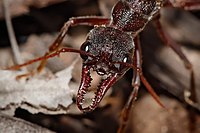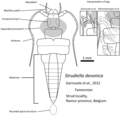The Insects Portal


Insects (from Latin insectum) are hexapod invertebrates of the class Insecta. They are the largest group within the arthropod phylum. Insects have a chitinous exoskeleton, a three-part body (head, thorax and abdomen), three pairs of jointed legs, compound eyes, and a pair of antennae. Insects are the most diverse group of animals, with more than a million described species; they represent more than half of all animal species. (Full article...)
Selected article -
Sphecius grandis, also called the western cicada killer, is a species of cicada killer wasp (Sphecius). The western species shares the same nesting biology as its fellow species, the eastern cicada killer (S. speciosus). S. grandis, like all other species of the genus Sphecius, mainly provides cicadas for its offspring. It forms nest aggregations and mates and broods once in a year, in July and early August. The wasp is on average 3 cm (1 in) to 5 cm (2 in) in length and is amber-yellow with yellow rings on its abdomen.
Wasps in the genus Sphecius are not habitually aggressive and use their venom mainly to paralyse cicadas which they take back to their nests to feed their young. The females catch around four or more cicadas for provisioning, place them in brood cells and lay eggs in the cells. S. grandis is endemic to Central America, Mexico and the Western United States, and is found at a higher mean altitude than other species of Sphecius. The western cicada killer males emerge earlier than females, but generally die after only a couple of days. (Full article...)Did you know -
- ... that the seeds of the European sedge Carex pilulifera may be dispersed by the ant Myrmica ruginodis?
- ... that the oldest known member of the mayfly family Neoephemeridae is the Eocene species Neoephemera antiqua?
- ... that Sphecius grandis, the Western cicada killer wasp, paralyzes cicadas for its offspring to eat after hatching?
- ... that the extinct griffenfly genus Bohemiatupus inhabited peat-mires?
- ... that the extinct hangingfly genera Formosibittacus, Jurahylobittacus, and Mongolbittacus are only known from the Middle Jurassic of China?
List articles
Related portals
General images -
Selected image -

The yellow fever mosquito, Aedes aegypti (Diptera: Culicidae), is a mosquito that can spread the dengue fever, Chikungunya and yellow fever viruses, and other diseases. It can be recognized by white markings on legs and a marking in the form of a lyre on the thorax.
WikiProjects

Main WikiProject:
Related projects:
- WikiProject Arthropods
- WikiProject Spiders
- WikiProject Animals
- WikiProject Tree of Life
- WikiProject Biology
Daughter projects:
Tasks
 |
Here are some tasks awaiting attention:
|
Associated Wikimedia
The following Wikimedia Foundation sister projects provide more on this subject:
-
 Commons
Commons
Free media repository -
 Wikibooks
Wikibooks
Free textbooks and manuals -
 Wikidata
Wikidata
Free knowledge base -
 Wikinews
Wikinews
Free-content news -
 Wikiquote
Wikiquote
Collection of quotations -
 Wikisource
Wikisource
Free-content library -
 Wikiversity
Wikiversity
Free learning tools -
 Wiktionary
Wiktionary
Dictionary and thesaurus
-

-

-

-

-
Random portal
Purge server cache







































